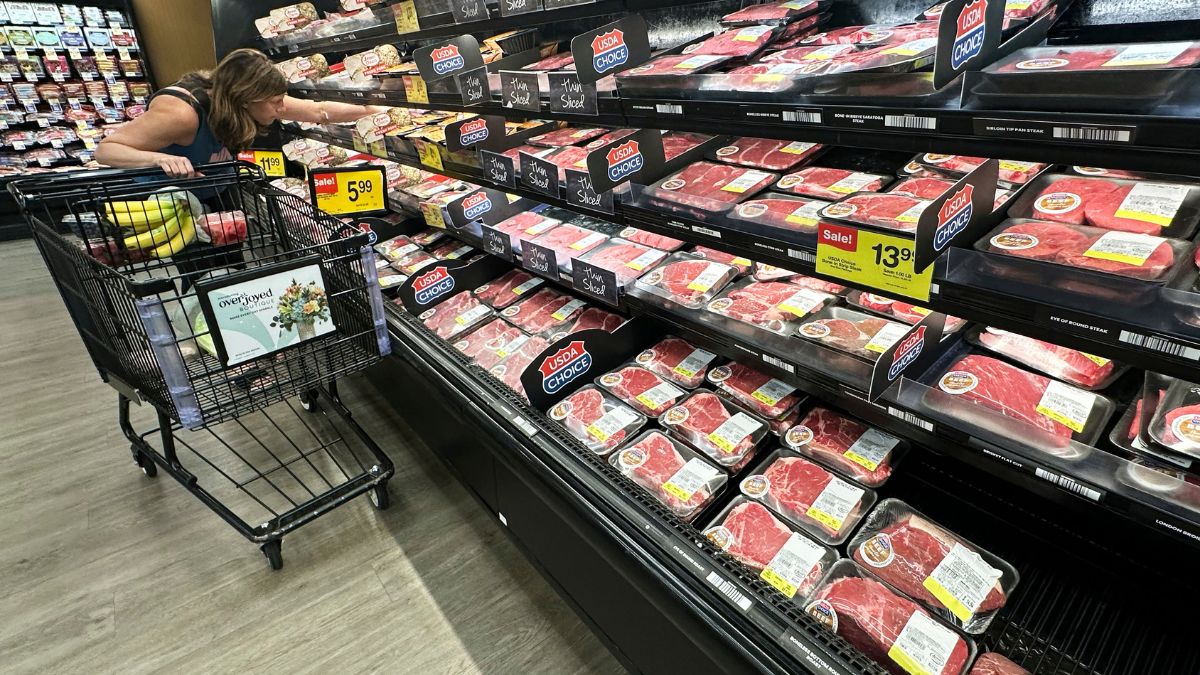Anyone lighting up their grill this summer in the United States is likely aware that burgers and steaks are costlier than ever, and recent data confirms that beef prices have surged to historic highs.
Experts caution that any significant drop in prices isn’t expected in the near term.
As per US government statistics, the average cost of a pound of ground beef reached $6.12 in June — an increase of nearly 12 per cent over the past year.
Likewise, the average cost for all uncooked beef steaks climbed 8 per cent to $11.49 per pound.
However, the increase in beef prices isn’t a new development.
Prices have been on an upward trajectory for two decades due to limited cattle supply and steady demand for beef.
In fact, the nation’s cattle inventory has been shrinking steadily over the years.
On January 1, the US had 86.7 million cattle and calves — 8 per cent lower than the 2019 peak — marking the smallest herd since 1951, according to the US Department of Agriculture.
Multiple factors have driven this decline, including prolonged drought and fluctuating cattle prices.
More recently, the appearance of a harmful parasite in Mexico and the looming threat of tariffs could reduce supply further and push prices even higher.
Here’s what’s behind the ongoing rise in beef prices:
Shrinking cattle population
Ranchers have become more efficient at producing beef from fewer animals by breeding larger cattle, explained David Anderson, a livestock economist at Texas A&M, to AP.
But in 2020, a prolonged drought began that dried up grazing land and drove up cattle feed costs, as reported by the American Farm Bureau.
Drought conditions have continued across the western US, and higher feed expenses have strained already narrow profit margins for cattle producers.
In response, many farmers increased the number of female cattle sent to slaughter, which provided short-term supply boosts but reduced the potential for herd growth. With fewer cattle available, beef prices rose.
In recent years, cattle prices have climbed sharply, with individual animals now selling for thousands of dollars. Recent figures indicate prices of over $230 per hundredweight (100 pounds).
These soaring prices have incentivised ranchers to cash in immediately rather than retain cows for breeding, Anderson said.
“For them, the balance is, ‘Do I sell that animal now and take this record high check?’ Or ‘do I keep her to realise her returns over her productive life when she’s having calves?’” Anderson said.
“And so it’s this balancing act and so far the side that’s been winning is to sell her and get the check.”
Emerging threat from disease
The spread of a flesh-eating parasite among cattle in Mexico has added to the supply constraints, especially since US officials halted cattle imports from Mexico last year.
Mexico previously accounted for about 4 per cent of the cattle the US finishes for beef production.
The parasite, known as the New World screwworm fly, lays its eggs in wounds on warm-blooded animals.
The fly’s larvae feed on living tissue — unlike most flies that consume dead matter — raising concerns among US officials about potential outbreaks in Texas, which could mirror the severe economic impact the pest caused before being eradicated in the US decades ago.
Bernt Nelson, an agricultural economist with the Farm Bureau, said the import ban has further squeezed supply, adding upward pressure on prices.
Potential tariff effects
Tariffs enacted by US President Donald Trump haven’t yet had a dramatic effect on beef prices, but they could add strain in the future. The US imports over 4 million pounds of beef annually.
Most imports consist of lean beef trimmings used by meatpackers to blend with fattier domestic beef to produce the preferred ground beef varieties for US consumers.
While lean beef from Australia and New Zealand faces a relatively low 10 per cent tariff, imports from Brazil — another major supplier — could be hit with tariffs of up to 50 per cent, as Trump has proposed.
If such tariffs persist, processors will be forced to pay more for imported lean beef — a product that US producers are not well-equipped to substitute because domestic beef production focuses largely on marbled, fattier cuts.
Beef demand remains strong
Even as prices soar, demand for beef in the US continues to be strong during peak grilling season. Kansas State agricultural economist Glynn Tonsor said this sustained demand is contributing to elevated prices.
Though high costs could eventually shift consumer habits — prompting more hamburger purchases over steak — that shift hasn’t happened on a large scale yet.
There also hasn’t been a significant move toward alternatives like pork or chicken.
Nelson noted that recent improvements in pasture conditions due to easing drought, as well as declining grain prices caused by reduced export demand for corn, may encourage ranchers to retain more cows for breeding.
These high cattle prices could also incentivise herd expansion.
Still, even if ranchers decide to grow their herds, the process takes time.
It would require a minimum of two years to breed and raise more cattle, and any uptick in herd numbers wouldn’t be evident until later this fall, which is when many ranchers make breeding decisions.
“We’ve still got a lot of barriers in the way to grow this herd,” Nelson said.
He pointed out that a new farmer looking to buy 25 bred heifers would need more than $100,000 at auction — a tall order with today’s high borrowing costs.
Typically, beef prices dip seasonally as grilling activity wanes in the fall. But given current dynamics, any such price drop is expected to be slight.
Also Watch:
With inputs from AP


)

)
)
)
)
)
)
)
)



